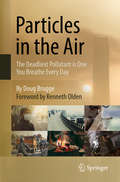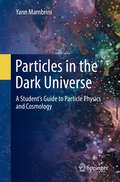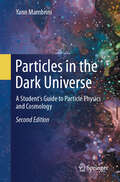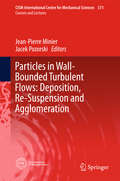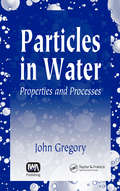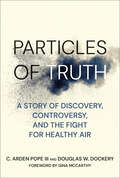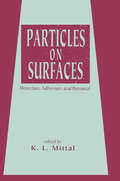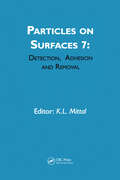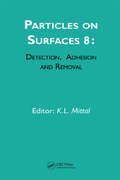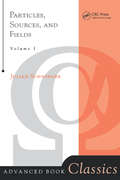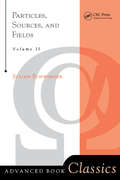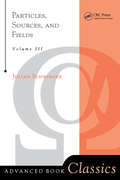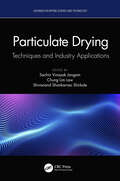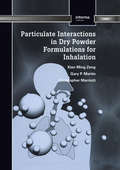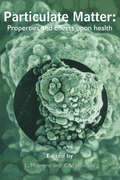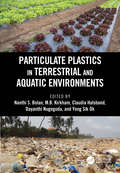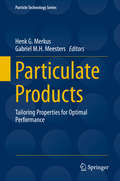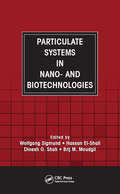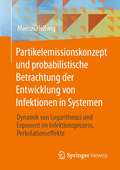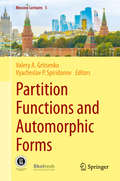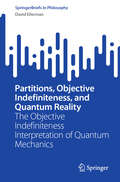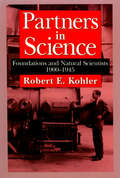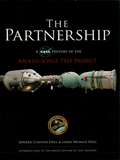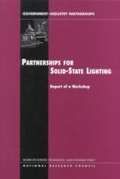- Table View
- List View
Particles in the Air: The Deadliest Pollutant is One You Breathe Every Day
by Doug BruggeThe book covers the three largest sources of particulate matter pollution in five chapters. These sources constitute three of the top ten public health problems in the world today and far outstrip any other environmental health threats in terms of health impact. The book begins with indoor solid fuel combustion for cooking in lower income countries and tells the story of how this problem was identified and recent efforts to eliminate it. The book next looks at tobacco smoking and second hand smoke, again reviewing the history of how these problems were identified scientifically and the fierce industry push back against the science. The last two chapters cover ambient particulate matter in the outdoor air. They address fine and ultrafine particles, describing the pioneering work on fine PM, the subsequent industry attacks on the scientists and then the emerging interest and concern about ultrafine particles, an area of research in which the author has participated. This book is geared towards non-scientists, including high school and college students.
Particles in the Dark Universe: A Student’s Guide to Particle Physics and Cosmology
by Yann MambriniThis book provides a comprehensive and instructive coverage of particle physics in the early universe, in a logical way. It starts from the thermal history of the universe by investigating some of the main arguments such as Big Bang nucleosynthesis, the cosmic microwave background (CMB) and the inflation, before treating in details the direct and indirect detection of dark matter and then some aspects of the physics of neutrino. Following, it describes possible candidates for dark matter and its interactions.The book is targeted at theoretical physicists who deal with particle physics in the universe, dark matter detection and astrophysical constraints, and at particle physicists who are interested in models of inflation or reheating. This book offers also material for astrophysicists who work with quantum field theory computations. All that is useful to compute any physical process is included: mathematical tables, all the needed functions for the thermodynamics of early universe and Feynman rules. In light of this, this book acts as a crossroad between astrophysics, particle physics and cosmology.
Particles in the Dark Universe: A Student’s Guide to Particle Physics and Cosmology
by Yann MambriniThis second edition of Particles in the Dark Universe has been substantially enhanced with several new chapters that delve into crucial aspects of particle physics in the Universe. These additions encompass the role of primordial black holes in the early universe, tracing their formation to decay, unification theories, a comprehensive historical overview of cosmological models, an extensive examination of the physics of the graviton, and an educational exploration of gravitational phenomena such as Unruh-type or Hawking radiation. Additionally, this edition incorporates 30 new exercises and provides a comprehensive presentation of inflationary models, along with a pedagogical insight into the mechanism of baryogenesis. Structured in a logical sequence, this book offers a thorough and instructional exploration of particle physics within the early universe. It initiates by elucidating the thermal history of the universe, delving into pivotal concepts like Big Bang nucleosynthesis, the cosmic microwave background (CMB), and inflation. Subsequently, it meticulously addresses both direct and indirect detection methods of dark matter, followed by an in-depth analysis of neutrino physics. The book further scrutinizes potential candidates for dark matter and their interactions. Designed for theoretical physicists engaged in particle physics within the universe, dark matter detection, astrophysical constraints, and those interested in models of inflation or reheating, this book also caters to astrophysicists involved in quantum field theory computations. It encompasses all essential elements required for computing various physical processes, providing mathematical tables, necessary thermodynamic functions for the early universe, and Feynman rules. Consequently, this book serves as an intersecting point between astrophysics, particle physics, and cosmology.
Particles in Wall-Bounded Turbulent Flows: Deposition, Re-Suspension and Agglomeration
by Jean-Pierre Minier Jacek PozorskiThe book presents an up-to-date review of turbulent two-phase flows with the dispersed phase, with an emphasis on the dynamics in the near-wall region. New insights to the flow physics are provided by direct numerical simuation and by fine experimental techniques. Also included are models of particle dynamics in wall-bounded turbulent flows, and a description of particle surface interactions including muti-layer deposition and re-suspension.
Particles in Water: Properties and Processes
by John GregoryBased on the author‘s more than 35 years of experience, Particles in Water: Properties and Processes examines particles and their behavior in water systems. The book offers clear and accessible methods for characterizing a range of particles both individually and as aggregates. The author delineates the principles for understanding particle
Particles of Truth: A Story of Discovery, Controversy, and the Fight for Healthy Air
by null C. Arden Pope III null Douglas W. DockeryA compelling, real-life account of how scientists uncovered air pollution&’s deadly impact on human health—and the contentious battles to use key scientific evidence in the critical fight for clean air.Particles of Truth is a riveting account of the discovery of the critical health effects of air pollution told by Arden Pope and Douglas Dockery, who have been at the forefront of air pollution and health research for four decades. With an insightful foreword by former EPA Administrator Gina McCarthy, this compelling book provides an inside look at groundbreaking scientific research and ensuing political and public-policy battles. It presents evidence that air pollution is a major contributor to disease and death and that reducing air pollution saves lives. The book also delves into intense efforts to discredit and cast doubt on the science.Through firsthand accounts, Pope and Dockery bring the scientific discoveries regarding the health effects of air pollution and accompanying controversies to life. They describe the real-world challenges of conducting impactful research when public health clashes with economic interests and politics. Despite these challenges, they and their colleagues persisted, accumulating evidence that supports landmark clean-air legislation and pollution reduction efforts worldwide. More than an inside look at pioneering air pollution research and the hidden health burden of air pollution, Particles of Truth is a story of determination and perseverance by those working to protect air quality and our health; indeed, their efforts have contributed to improvements in public health and an increase in longevity. For anyone interested in public health, environmental quality, or public policy, this is a must-read book that takes you to the front lines of discovery and controversy.
Particles on Surfaces: Detection: Adhesion, and Removal
by K. L. MittalThis work comprises the proceedings of the Fourth Symposium on Particles on Surfaces. Papers cover: adhesion-induced deformations of particles on surfaces; the use of atomic force microscopy in probing particle-particle adhesion; particle contamination in microelectronics, on spacecraft, and on optical surfaces; the role of air ionization in reducing surface contamination by particles in the cleanroom; abrasive blasting media for contamination-free deburring processes; and more.;The book is intended for physical, chemical, surface and colloid chemists, materials scientists; polymers, plastics, electrical and electronics, computer, chemical and mechanical engineers; and upper-level undergraduate and graduate students in these disciplines.
Particles on Surfaces: Detection, Adhesion And Removal
by K. L. MittalThis volume documents the proceedings of the 7th International Symposium on Particles on Surfaces: Detection, Adhesion and Removal held in Newark, NJ, June 19-21, 2000. The study of particles on surfaces is extremely important in a host of diverse technological areas, ranging from microelectronics to optics to biomedical. This volume contains a total of 28 papers, which were all properly peer reviewed, revised and edited before inclusion. Therefore, this book is not merely a collection of unreviewed manuscripts, but rather represents information which has passed peer scrutiny. Furthermore, the authors were asked to update their manuscripts, so the information contained in this book should be current and fresh. This volume is divided into two parts: 1) Particle Analysis and General Cleaning-Related Topics; and 2) Particle Adhesion and Removal. The topics covered include: surface analysis techniques for particle identification; cleaning, rinsing and drying issues in post-CMP cleaning; fundamental forces involved in particle adhesion; factors affecting adhesion of small (nanosize) particles; factors important in particle detachment; particle adhesion measurement by AFM; various (wet and dry) techniques for particle removal, e.g., laser, ultrasonic, megasonic, use of surfactants; toner particles and pharmaceutical particles. This volume offers a wealth of information on the tremendously technologically important field of particles on surfaces and should provide a consolidated source of current R&D activity in this arena. Therefore, it will be of value and use to anyone interested in the topic of particles on surfaces.
Particles on Surfaces: Detection, Adhesion and Removal, Volume 8
by K. L. MittalThis volume documents the proceedings of the 8th International Symposium on Particles on Surfaces: Detection, Adhesion and Removal held in Providence, Rhode Island, June 24a 26, 2002. The study of particles on surfaces is extremely crucial in a host of diverse technological areas, ranging from microelectronics to optics to biomedical. In a world o
Particles, Sources, And Fields, Volume 1 (Advanced Books Classics Ser. #1)
by Julian SchwingerThis classic, the first of three volumes, presents techniques that emphasize the unity of high-energy particle physics with electrodynamics, gravitational theory, and many-particle cooperative phenomena. What emerges is a theory intermediate in position between operator field theory and S-matrix theory, which rejects the dogmas of each and gains thereby a calculational ease and intuitiveness that make it a worthy contender to displace the earlier formulations.
Particles, Sources, And Fields, Volume 2 (Advanced Books Classics Ser. #1)
by Julian SchwingerThis classic book (volume two of three volumes) is almost exclusively concerned with quantum electrodynamics. As such, it is retrospective in its subject matter. The topics discussed range from anomalous magnetic moments and vacuum polarization, in a variety of applications, to the energy level displacements in hydrogenic atoms, with occasional excursions into nuclear and high-energy physics. Based as it is upon the conceptually and computationally simple foundations of source theory, little in the way of formal mathematical apparatus is required, and thus most of the book is devoted to the working out of physical problems.
Particles, Sources, And Fields, Volume 3 (Advanced Books Classics Ser. #1)
by Julian SchwingerAn extension of Dr. Schwinger's two previous classic works, this volume contains four sections in addition to the previous sections of Electrodynamics II, which were concerned with the two-particle problem, and applications to hydrogenic atoms, positronium, and muonium.
Particulate Drying: Techniques and Industry Applications (Advances in Drying Science and Technology)
by Sachin Vinayak Jangam Chung Lim Law Shivanand Shankarrao ShirkoleIn the process industry, understanding the unit operation of particulate drying is imperative to yield products with desired properties and characteristics and to ensure process safety, optimal energy efficiency and drying performance, as well as low environmental impact. There are many techniques and tools available, which can cause confusion. Particulate Drying: Techniques and Industry Applications provides an overview of various particulate drying techniques, their advantages and limitations, industrial applications, and simple design methods. This book: • Covers advances in particulate drying and their importance in the process industry • Highlights recent developments in conventional drying techniques and new drying technologies • Helps readers gain insight into selecting the appropriate drying techniques for a particular product • Summarizes various applications from a wide range of industries, including chemical, food, pharmaceutical, biotech, polymer, mineral, and agro-industries • Projects future research trends and demands in particulate drying This book serves as a reference for process and plant engineers as well as researchers in the fields of particulate processing, mineral processing, food processing, chemical engineering, and mechanical engineering, especially those involved in the selection of drying equipment for particulate solids and R&D of drying of particulate materials.
Particulate Interactions in Dry Powder Formulation for Inhalation
by Xian Ming Zeng Gary Peter Martin Christopher MarriottInteractions between drug particulates are crucial in determining drug dispersion and deaggregation, and ultimately delivery efficiency. This book combines principles and factors in pharmaceutical powder technology, critically reviews some of the studies carried out in dry powder formulation development, and proposes possible strategies for improvi
Particulate Matter: Properties and Effects on Health
by Dr R Maynard Vyvyan HowardThis is a rapidly expanding and highly topical research area. Written by authors and editors who are well known and respected in their fields, this text looks at the health effects caused by particulate aerosols, and discusses recent legislation and future strategies.
Particulate Plastics in Terrestrial and Aquatic Environments
by Nanthi S. Bolan, M.B. Kirkham, Claudia Halsband, Dayanthi Nugegoda, Yong Sik OkThe manufacture of plastic as well as its indiscriminate disposal and destruction by incineration pollutes atmospheric, terrestrial, and aquatic ecosystems. Synthetic plastics do not break down; they accumulate in the environment as macro-, micro-, and nanoplastics. These particulate plastics are a major source of pollutants in soil and marine ecosystems. Particulate Plastics in Terrestrial and Aquatic Environments provides a fundamental understanding of the sources of these plastics and the threats they pose to the environment. The book demonstrates the ecotoxicity of particulate plastics using case studies and offers management practices to mitigate particulate plastic contamination in the environment. Features · Describes physical and chemical properties of particulate plastics in terrestrial and aquatic ecosystems · Presents information on characteristics of particulate plastics as impacted by weathering processes · Provides numerous approaches for managing particulate plastic contamination · Identifies sources of particulate plastics in the environment; distribution and characteristics of particulate plastics; and management strategies of particulate plastics Written by a global team of scientists, this book is for researchers in the fields of environmental safety and waste management or individuals interested in the impact of particulate plastics on environmental health.
Particulate Products
by Henk G. Merkus Gabriel M.H. MeestersParticulate products make up around 80% of chemical products, from all industry sectors. Examples given in this book include the construction materials, fine ceramics and concrete; the delicacies, chocolate and ice cream; pharmaceutical, powders, medical inhalers and sun screen; liquid and powder paints. Size distribution and the shape of the particles provide for different functionalities in these products. Some functions are general, others specific. General functions are powder flow and require - at the typical particulate concentrations of these products - that the particles cause adequate rheological behavior during processing and/or for product performance. Therefore, this book addresses particle packing as well as its relation to powder flow and rheological behavior. Moreover, general relationships to particle size are discussed for e. g. color and sensorial aspects of particulate products. Product-specific functionalities are often relevant for comparable product groups. Particle size distribution and shape provide, for example, the following functionalities: - dense particle packing in relation to sufficient strength is required in concrete construction, ceramic objects and pharmaceutical tablets - good sensorial properties (mouthfeel) to chocolate and ice cream - effective dissolution, flow and compression properties for pharmaceutical powders - adequate hiding power and effective coloring of paints for protection and the desired esthetical appeal of the objects - adequate protection of our body against sun light by sunscreen - effective particle transport and deposition to desired locations for medical inhalers and powder paints. Adequate particle size distribution, shape and porosity of particulate products have to be achieved in order to reach optimum product performance. This requires adequate management of design and development as well as sufficient knowledge of the underlying principles of physics and chemistry. Moreover, flammability, explosivity and other health hazards from powders, during handling, are taken into account. This is necessary, since great risks may be involved. In all aspects, the most relevant parameters of the size distribution (and particle shape) have to be selected. In this book, experts in the different product fields have contributed to the product chapters. This provides optimum information on what particulate aspects are most relevant for behavior and performance within specified industrial products and how optimum results can be obtained. It differs from other books in the way that the critical aspects of different products are reported, so that similarities and differences can be identified. We trust that this approach will lead to improved optimization in design, development and quality of many particulate products.
Particulate Systems in Nano- and Biotechnologies
by Brij M. Moudgil Wolfgang Sigmund Hassan El-Shall Dinesh O. ShahDespite the widespread growth and acceptance of particulate technology, challenges in the design, operation, and manufacturing of these systems still exists. These critical issues must be resolved so that particle technology may continue to serve as a foundation for new nano and biotechnologies. Particulate Systems in Nano- and Biotechnologies pres
Partikelemissionskonzept und probabilistische Betrachtung der Entwicklung von Infektionen in Systemen: Dynamik von Logarithmus und Exponent im Infektionsprozess, Perkolationseffekte
by Marcus HellwigDas Buch beschreibt die Möglichkeit, eine probabilistische Prognose zu erstellen, die den mittleren n-Tage-Logarithmus von Fallzahlen in der Vergangenheit verwendet, um einen Exponenten für eine Wahrscheinlichkeitsdichte für eine Prognose zu bestimmen, als auch das Partikelemissionskonzept, das sich herleitet aus Kontakt- und Verteilungsrate, welche den Exponenten der voraussichtlichen Entwicklung in dem Maß erhöht wie sich eine Gruppenbildung von Personen bilden kann.
Partition Functions and Automorphic Forms (Moscow Lectures #5)
by Valery A. Gritsenko Vyacheslav P. SpiridonovThis book offers an introduction to the research in several recently discovered and actively developing mathematical and mathematical physics areas. It focuses on: 1) Feynman integrals and modular functions, 2) hyperbolic and Lorentzian Kac-Moody algebras, related automorphic forms and applications to quantum gravity, 3) superconformal indices and elliptic hypergeometric integrals, related instanton partition functions, 4) moonshine, its arithmetic aspects, Jacobi forms, elliptic genus, and string theory, and 5) theory and applications of the elliptic Painleve equation, and aspects of Painleve equations in quantum field theories. All the topics covered are related to various partition functions emerging in different supersymmetric and ordinary quantum field theories in curved space-times of different (d=2,3,…,6) dimensions. Presenting multidisciplinary methods (localization, Borcherds products, theory of special functions, Cremona maps, etc) for treating a range of partition functions, the book is intended for graduate students and young postdocs interested in the interaction between quantum field theory and mathematics related to automorphic forms, representation theory, number theory and geometry, and mirror symmetry.
Partitions, Objective Indefiniteness, and Quantum Reality: The Objective Indefiniteness Interpretation of Quantum Mechanics (SpringerBriefs in Philosophy)
by David EllermanThis book presents a new ‘partitional' approach to understanding or interpreting the math of standard quantum mechanics (QM). The thesis is that the mathematics (not the physics) of QM is the Hilbert space version of the math of partitions on a set and, conversely, the math of partitions is a skeletonized set level version of the math of QM. Since at the set level, partitions are the mathematical tool to represent distinctions and indistinctions (or definiteness and indefiniteness), this approach shows how to interpret the key non-classical QM notion of superposition in terms of (objective) indefiniteness between definite alternatives (as opposed to seeing it as the sum of ‘waves'). Thus, the book develops a new mathematical, or indeed, logical, approach to the century-old problem of interpreting quantum mechanics, ensure it is of interest to philosophers of science as well as mathematicians and physicists.
Partners in Science: Foundations and Natural Scientists, 1900-1945
by Robert E. KohlerRobert Kohler shows exactly how entrepreneurial academic scientists became intimate "partners in science" with the officers of the large foundations created by John D. Rockefeller and Andrew Carnegie, and in so doing tells a fascinating story of how the modern system of grant-getting and grant-giving evolved, and how this funding process has changed the way laboratory scientists make their careers and do their work. "This book is a rich historical tapestry of people, institutions and scientific ideas. It will stand for a long time as a source of precise and detailed information about an important aspect of the scientific enterprise. . .It also contains many valuable lessons for the coming years."—John Ziman, Times Higher Education Supplement
Partners in Science: Foundations and Natural Scientists, 1900-1945
by Robert E. KohlerRobert Kohler shows exactly how entrepreneurial academic scientists became intimate "partners in science" with the officers of the large foundations created by John D. Rockefeller and Andrew Carnegie, and in so doing tells a fascinating story of how the modern system of grant-getting and grant-giving evolved, and how this funding process has changed the way laboratory scientists make their careers and do their work. "This book is a rich historical tapestry of people, institutions and scientific ideas. It will stand for a long time as a source of precise and detailed information about an important aspect of the scientific enterprise. . .It also contains many valuable lessons for the coming years."—John Ziman, Times Higher Education Supplement
The Partnership: A NASA History of the Apollo-Soyuz Test Project (Dover Books on Astronomy)
by Paul Dickson Edward Clinton Ezell Linda Neuman EzellThe 1975 Apollo-Soyuz Test Project (ASTP) was the first joint U.S.-Soviet space flight, in which teams from the two nations met in orbit to test an international docking system and conduct both collaborative and independent studies. Although primarily a symbol of international goodwill, the mission provided useful experience for future cooperative ventures between the two nations. This authorized NASA history features many fascinating interviews with participants as well as firsthand observations of ASTP activities.Because details of the Soviet space program remained shrouded in secrecy during the ASTP, the story is told from the American perspective. No scientific background is necessary to appreciate the narrative, which focuses on the participants' working relationships rather than the technical aspects of their jobs. Starting with the early years of the Cold War competition, it traces the formation of an alliance between NASA and Soviet Academy engineers in developing a test project, training the crew, and the triumphant flight. Eighty-six pages of photographs include twelve full-color pages with images of Earth from space.
PARTNERSHIP FOR SOLID-STATE LIGHTING: Report of a Workshop
by Technology Board On Science Economic PolicyAs part of its analysis of public-private partnerships, the Academies convened leading academic researchers, government officials and policy makers, and representatives from large and small firms to explore the potential contributions, technical challenges, and opportunities for government-industry-university collaboration in the area of solid-state lighting. The workshop report devotes special attention to the potential for substantial social benefits—relating to the environment, energy consumption, and national security—that could arise with the widespread use of solid-state lighting technology. The workshop also focused on the technical and competitive hurdles currently faced in bringing solid-state lighting to market and the potential contributions of a well-conceived national consortium for solid-state lighting research.
